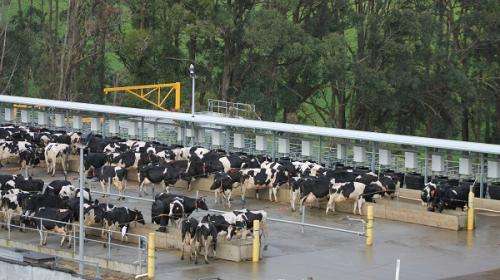Rain shortfall pushes farm diversification

Dairy farmers are being urged to diversify their farms to protect profit margins amid declining rainfall and fluctuating production costs.
Collaborative research between Western Australian and Victorian institutions shows farm profitability is affected more by changes in rainfall than commodity prices, with dairy enterprises the most profitable on a $/ha basis.
Profitability of wheat, steer and prime lamb enterprises however, proved most resilient during times of low rain.
Compared to Victoria, WA's dairy industry is relatively small, producing around 335 million litres of milk annually compared to Victoria's 6,040 million litres.
However, WA's wheat production is more than double that of Victoria.
The study used correlated price and cost datasets over the past nine years to analyse fourteen representative farm enterprises in south eastern Australia. These sets were used to assess profitability under low, average and high rainfall scenarios.
University of Melbourne expert and lead researcher Natalie Browne says the farms involved in the study included Merino wool, prime lamb, beef cattle, milk, wheat and canola.
"Computer modelling of farm systems allows a number of different scenarios to be tested, such as how the profitability of numerous farm enterprises were affected by low, median and high rainfall scenarios," she says.
"Dairy enterprises were the most profitable, both in $/ha and in $/farm, however their profit also varied more than the other enterprises, particularly under low rainfall situations.
"Overall, the results showed that low rainfall had a greater impact on profitability than low commodity prices for things like meat, milk and wheat, on all farms except the wheat enterprise."
The models were examined for 30 years to capture the variations that occur in climate and pasture composition over that time.
University of Western Australia Professor Ross Kingwell says wheat-growing in many parts of southern Australia has been affected by a drying trend in recent decades, but technologies like dry-sowing, direct seeding and use of liquid nitrogen have softened the potential impact.
"The other challenge for wheat farmers across Australia is managing their price risk," he says.
"Since marketing deregulation and the emergence of seemingly more frequent price spikes, wheat farmers now face the challenge of more volatile prices for their wheat.
Ms Browne says farm diversification involving combinations of enterprises with negatively correlated profits will enable the variance in farm profits to be reduced.
This should form part of farms' adaptation strategies to climate and price variability, she says.
"Rainfall is estimated to decline in the future for the study region as a result of climate change," she says.
More information: Natalie Browne, Ross Kingwell, Ralph Behrendt, Richard Eckard, "The relative profitability of dairy, sheep, beef and grain farm enterprises in southeast Australia under selected rainfall and price scenarios," Agricultural Systems, Volume 117, May 2013, Pages 35-44, ISSN 0308-521X, dx.doi.org/10.1016/j.agsy.2013.01.002.
Provided by Science Network WA


















